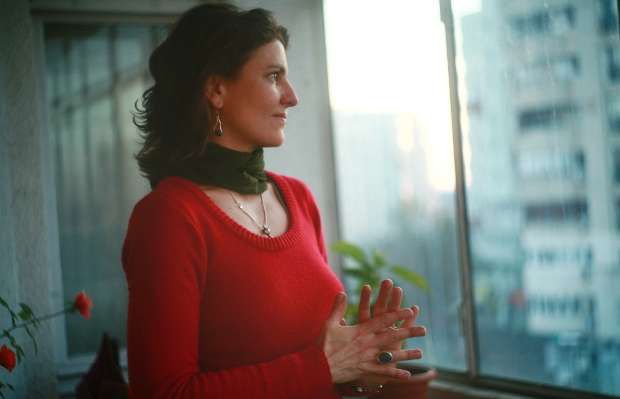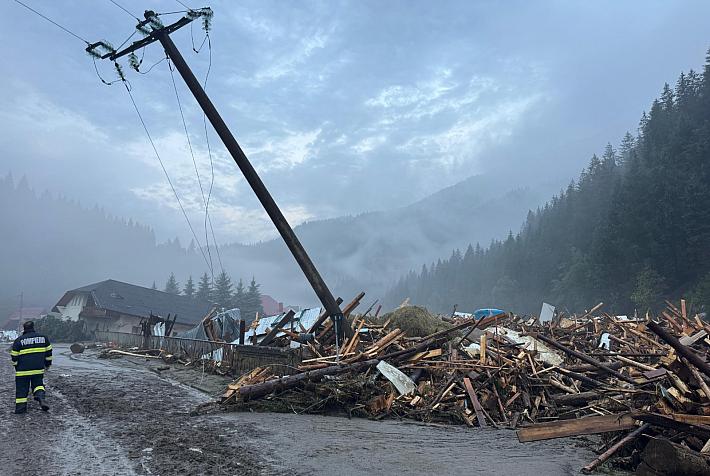Filmmaker Laura Beldiman walks the line between pressure and grace

The story of a woman who puts her courage on every morning.
In a small tea house in Bucharest, the waiter finally brings the latte and Laura Beldiman, Romanian-born documentary filmmaker who lives in France, takes a sip out of it. “It's not as hot as a latte should be,” she says. “I'm used to drinking it at a different temperature.” After a short hesitation, she asks the waiter to reheat it. “If you need something, it's good to ask for it.”
Soon after the fall of communism in Romania, a 20-year old Laura, freshly enrolled at the Academy of Economic Sciences in Bucharest, needed to understand what happened to Romania during the communism era. She somehow felt brain-washed, the victim of a regime and knew that the best way to move over victimization is to take a distance and make sense of the whole experience. So off she went to the United States with a study scholarship at the Smith College.
About 20 years later, Laura returned to Bucharest to do a documentary film about the famous singer Maria Tanase. A woman in her late thirties, with beautiful features which express both elegance and a certain tenseness, Laura had learned quickly that grace cannot be separated from pressure, like Hemingway said, and that if you really wanted something, you had to go out there and give it a try.
It was America’s lesson that if you have a good idea, you can do it, at any moment. “Rules are much clearer there and once you get to know them, it’s easier to get what you want,” Laura told me. She was a bit late for our meeting, because she had to stay up late to apply for a grant from the National Centre for Cinematography. They had changed the deadline for the submission of the projects twice- Romania’s lesson that if you have a good idea, there’s no guarantee you can do it.
A private liberal arts college for women located in Northampton, Massachusetts, Smith College was Laura's contamination to feminism, development anthropology and politics. Later she joined an NGO which fought to change the way the campaigns were financed. “A fish rots from the head down, so if you want to change something, you need to go down to the head, where the evil starts. In my view politics is the root cause,” Laura said. Finally she applied for a job at the National Geographic, first as an assistant editor in the photography department and later in the documentary section.
“During my studies and later on there was this question about Romania pending; why did our political and economic experiences have to be different, why did we choose that particular system?” Thousand of miles away from her birth country, Laura carried around this particular bitter pill, which instead of vanishing with time, extended to other areas. It became visible to her that the human structure in general displayed various inequalities mechanisms. “I became a militant and I wanted to fight for others. It was a drive to get out of your skin, of your own survival race and to fully dedicate yourself to a cause.”
The logistics of changing the world though, once Laura set upon this goal, proved a bit convoluted. “While working for that NGO, I realized that the idea of changing the world is not easy to carry out among others given various factors such as the dynamics of a group, the difficulties to pursue your aims. So I told myself that the most important thing in changing the world is changing somebody's mind and you can accomplish that by telling a story.” Documentary film offered the shell to tell stories and provided her with the freedom to work in small groups.
On March 21, 2002, the Afghan New Year’s Eve and the day the Afghan girls were allowed in schools again, Laura arrived at the Kabul International Airport. Still working for the National Geographic, Laura took a leap of faith and came to work for an organization which helped Afghan journalists rebuild mass-media. “The idea of changing the world was right in your hands.” She worked with the first women’s magazines in Kabul who needed an editor. Two journalists and a photographer she met there alongside a young girl studying medicine and also working in journalism became the characters in her first documentary movie called “Four Afghan Women”.
“What I learned there is not to view everything through my feminism, liberation-of-women-at-all-costs lens. It is a society with a very different structure, based on tribes where the individual freedom doesn’t really exist. You depend entirely on your relationships with the extended family and the tribe,” Laura said.
It was Afghanistan that cured her of any victimization leftovers and particularly of those relentless questions related to Romania, such as “why did we have such bad luck? why did things have to be like that?” “Witnessing the sufferings in Afghanistan, seeing all those people mutilated by war in a place where the sheer survival in peace is a huge triumph, you start to understand how relative things are, how relative your own suffering is.”
Laura returned to the United States, but she started to feel disconnected from her own past. Transience is the state or fact of lasting only for a short time and America is defined by transience, Laura explained. “People move often, they start over and they redefine themselves only in the now. I felt at a certain point that this part of the world was too much for me, because it somehow erases your history. Your past is like a part of your life you put on a shelf and it gets covered with dust and you ask yourself if you really lived in Romania.”
As a documentary filmmaker, it was even more difficult. “In the United States there are few financing possibilities and few TV channels broadcast auteur documentaries.” In 2007 Laura moved to France, where she found a new nest, as she calls it, a small production company. “It’s hard to survive there as well, as there are some big documentary companies which get the big contracts with the important televisions. Budgets got smaller, but we survive and continue to produce the stories we believe in.”
“I’m not famous, nor I wish to be,” Laura said. “The documentary is the Cinderella of the movie. We try to understand a certain human story and to share it.” Laura has documented musicians, unscrambled creation acts. Now she is working on Maria Tanase’s story and on a movie about Gisèle Casadesus, a French theatre actress who turns 100 this year.
The idea of changing the world has also evolved for Laura. “Maybe I haven’t followed anymore this idea of changing the world. But these stories have a meaning too. It’s the idea to share stories about special persons which can inspire, even if it’s not a political mission. Take Gisèle Casadesus’s story. She acted at age of 99 in a film called Sous le figuier directed by Anne-Marie Étienne.”
The idea of a movie about Maria Tanase first came to Laura in 2005, when she met Romanian-born musician Alexandru Balanescu, who had a project called Maria T. The story of this strong woman living in a patriarchal society, who managed to keep a certain artistic integrity despite all the authoritarian regimes she had lived through, was a great trigger for Laura. “I am happy in a way that Maria’s story brings me more often here and I can reconnect with the reality of this place.”
As I talked to Laura, I could trace a bit of American and French accent and I wondered if it’s wasn’t too difficult for her juggling with so many experiences and starting over again and again. “There are many “Frances” and many “Americas”; what matters are the islands you find there, the nests and the new families you build. Imagine an onion to which you add extra layers. Some things you get rid off with time, others you add. It’s important to keep searching, to be amazed; it’s like air to me.”
A few days after we had met, Laura returned to her home in Paris. It’s winter so she’ll spend most of her time in the montage studio, a space where she loses her own ego and dives into the story she edits. But as soon as it will get warmer, she’ll be walking again along San Martin Canal, which is pretty close to her home. The canal widens at Bassin de la Villette, where in summertime the oysters show up: young people having picnics, talking or singing.
By Diana Mesesan, features writer, diana@romania-insider.com
(photos by Diana Mesesan)












